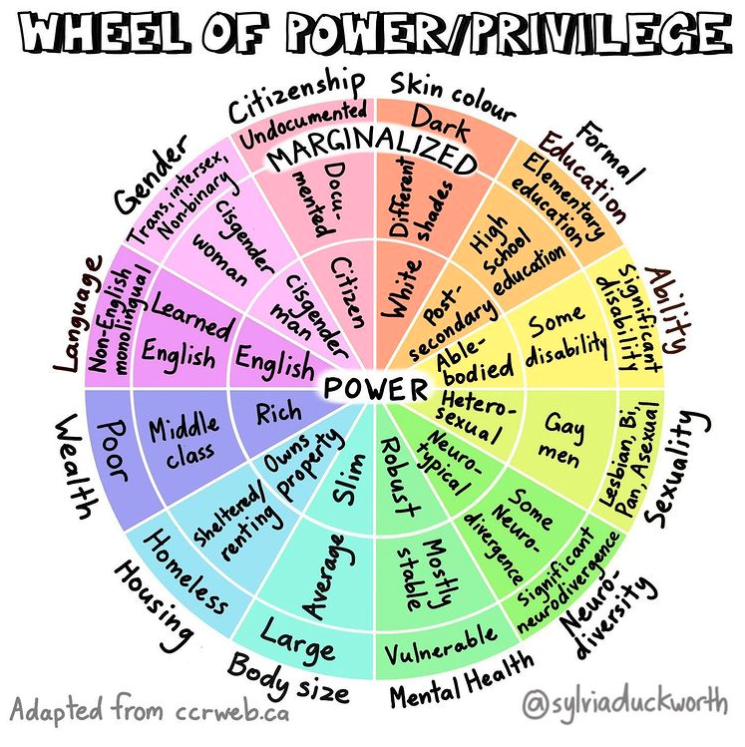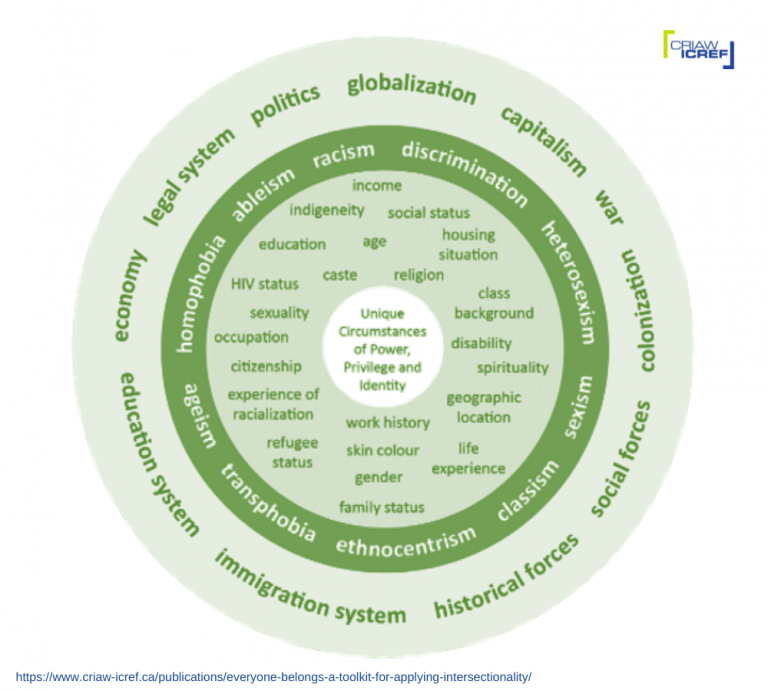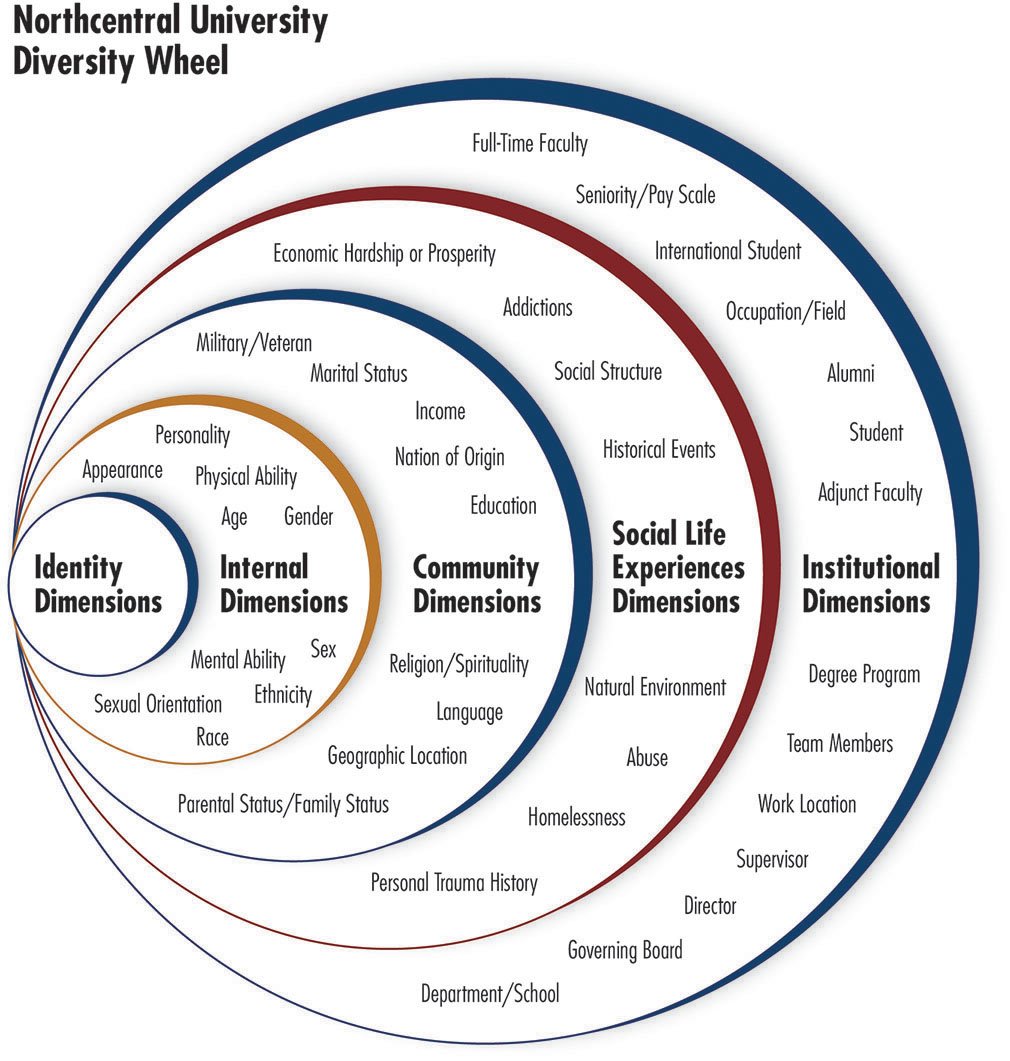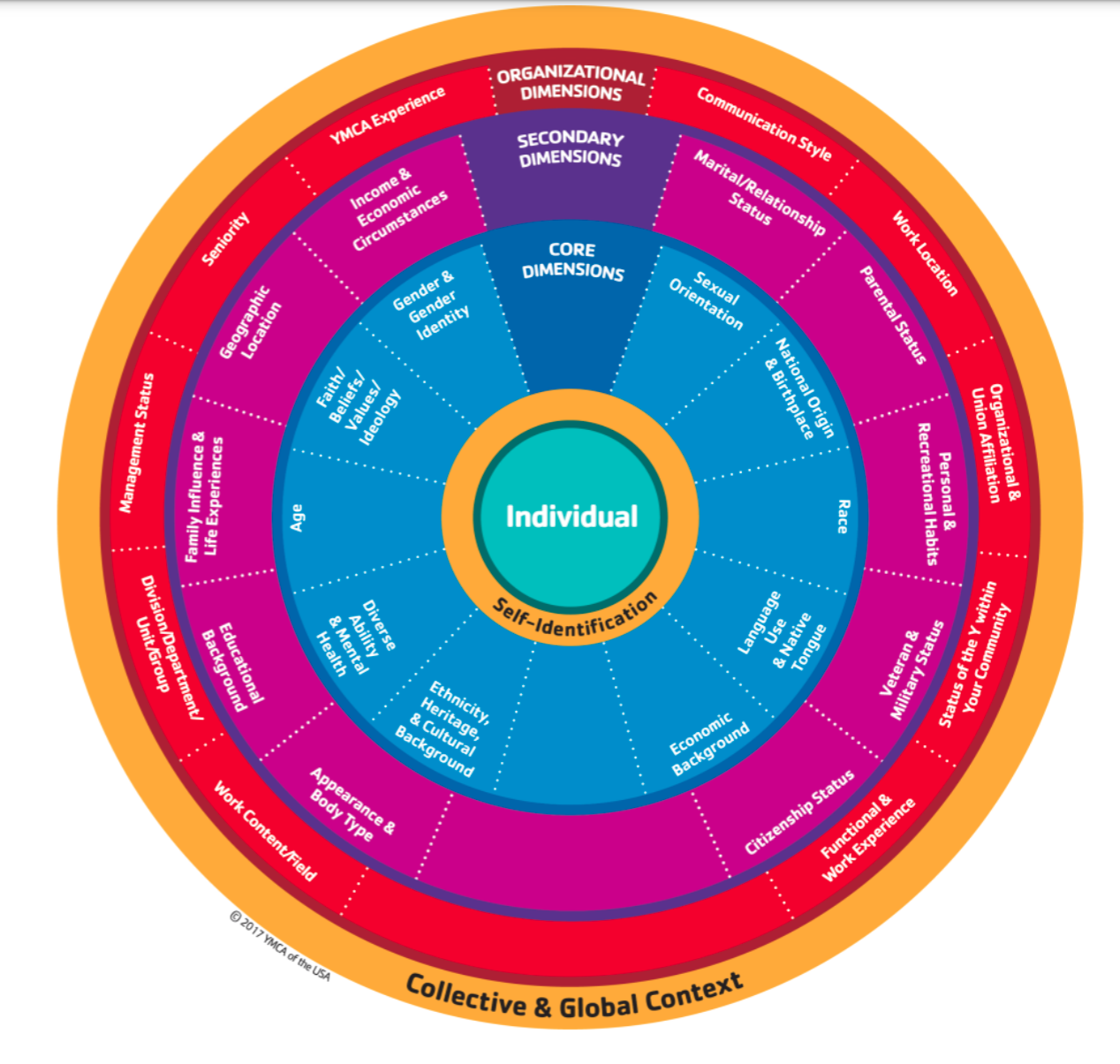Why Intersectionality Matters at Work (Part 1/4)
Intersectionality affects every aspect of our lives both within and beyond the realm of work, but it’s not always considered as a framework for meaningful change within organizations. In this series, we’ll walk you through some of the basics of intersectionality: What is it? Why does it matter for organizations? What can we do with this information? In each issue we’ll leave you with questions to help you apply these concepts to your work; we’ll also share all of our sources so you can use this information as a gateway to further learning, questioning, and action. Ready? Let’s go!
A cursory review of Google search trends shows a significant increase in searches for the term intersectionality over the past decade, and it's not just individual interest driving this upward trend; companies have been jumping on board as well. A custom search of Harvard Business Review alone turns up over 200 references to intersectionality since 1997, and well over half of those are from the past three years.
If you're a business leader, and you haven't encountered this idea in your work up to now, it will almost certainly come up soon. Luckily, you're in the right place for a brief introduction to the concept. Without further ado, here is Intersectionality: Part One.
What is Intersectionality?
Intersectionality is a framework or lens used to analyze or discuss multiple aspects of individual identity (e.g., race, class, gender, sexuality, etc.) and the unique privileges and oppressions individuals may experience where those identities overlap.
Dr. Kimberlé Crenshaw popularized the term through her decades of scholarly work on the unique forms of oppression Black women face in the US legal system. In her 2016 TED talk titled "The Urgency of Intersectionality," Dr. Crenshaw shares how her research revealed that intersections of race and gender, heterosexism, transphobia, xenophobia and other social dynamics create unique challenges for African American women and other socially marginalized people.
The concept of intersectional identities isn't only about race and gender. It encompasses any number of dimensions of identity, often represented in illustrations like the one above by Sylvia Duckworth or in examples like those below, which tend to illustrate both the overlapping dimensions of identity and related aspects of privilege and oppression.
Note: All of the examples above were created from US perspectives, and it’s important to keep in mind that social norms, laws, policies, and associated privileges/oppressions differ significantly by region and context. Also, while these graphics depict many aspects of identity, they are not inclusive of all aspects. Some organizational adaptations also include dimensions of identity that may be uniquely relevant to the social/cultural norms of that specific organization.
Developing intersectional awareness in the workplace gives us a way to recognize the specific challenges people may face in our organizations as a result of multiple forms of marginalization. It allows us to move beyond the common strategy of focusing on singular identities to identify group needs and gives us access to a more nuanced understanding of our colleagues, which helps ensure that "important information about the unfair impacts of politics and policies is less likely to fall through the cracks" (Hankivsky, 2014).
Imagine you’re responsible for getting a group of people across a large, hazardous river crossing (if you want to be nostalgic about it, imagine you’re playing Oregon Trail).
Your goal is to get the entire group across the river safely, and you need everyone’s skills and abilities to successfully make the rest of the journey after you reach the other side. Some folks are strong swimmers who can easily make their way across. Others are non-swimmers. To address this problem, you implement a plan to equally distribute floatation devices to all non-swimmers so they can float across. Unfortunately, the devices turn out to be too small for the larger members of the group, and they immediately begin to sink and have to scramble back to shore.
Obviously, this is a simplified and slightly tongue-in-cheek example, but imagine that you were in this same situation and applied a basic understanding of intersectionality! Instead of only considering singular dimensions of identity (swimmers and non-swimmers), you would have examined how everyone’s swimming abilities interacted with other dimensions of identity like their size, need to carry small children on their backs, etc. You may have been able to solve the entire problem at once by providing larger floatation devices from the beginning.
Awesome 90’s video games aside, one real-world example of how an intersectional lens can be applied to better understand a workplace challenge is around bullying. Anti-bullying initiatives have been on the rise in many companies, and research has demonstrated that intersectionality is an important consideration for any organization that hopes to reduce bullying in the workplace.
A 2018 study by Hollis showed that as an employee’s intersectionality became more complex, they were more likely to experience workplace bullying. The impacts on employees with multiple marginalized identities were significant. For instance, Hollis found that because of workplace bullying, Black women faced unfair demotion, threats of job loss, or job changes due to bullying much more often than employees who were Black (but not women) or women (who were not Black). This intersectional understanding of the disparity matters because the unique situation employees in the study were experiencing at the intersection of gender and race could easily be missed if we were only looking at data related to singular identities of race or gender.
Take a moment to scroll back up to the Venn diagram at the beginning of this post, and consider different dimensions of your own complex, colorful identity. If you separated each circle (your gender identity, your culture(s), your caregiver status, etc.) into their own little self-contained spaces without any overlaps, what aspects of your experience in the world might be lost? When we learn to recognize our identities as a kaleidoscope of overlapping dimensions instead of as a collection of discrete parts, we gain access to more nuanced information about our opportunities and challenges at each intersection.
Stay tuned for Intersectionality: Part Two, where we break down more reasons why intersectionality matters for organizations. In the meantime, consider the following reflection questions.
Reflection Questions
💡 What is an example of a challenge you face in the world or at work that exists at the intersection between two or more aspects of your identity?
💡 What is one way you imagine an intersectional lens could be applied to better understand peoples’ positive and negative experiences in your own organization.
💡 Watch Dr. Crenshaw’s TED talk. What do you notice about your own reaction to her opening exercise?
Share your ideas. Solve problems. Make a difference.
We’re building a community where your voice is heard, solutions are shared, and changemakers around the world can mobilize for change. If you are passionate about change, culture, and innovation, this is the place for you.
Sources & Related Reading
Advancing African-American Women in the Workplace: What Managers Need to Know. (2004). Catalyst. https://www.catalyst.org/research/advancing-african-american-women-in-the-workplace-what-managers-need-to-know/
Anti-oppression. (n.d.). Canadian Council for Refugees. Retrieved October 20, 2021, from https://ccrweb.ca/en/anti-oppression
Barton, D., & Yee, L. (2017). Time for a new gender-equality playbook. McKinsey. https://www.mckinsey.com/featured-insights/leadership/time-for-a-new-gender-equality-playbook
Bourabain, D. (2021). Everyday sexism and racism in the ivory tower: The experiences of early career researchers on the intersection of gender and ethnicity in the academic workplace. Gender, Work & Organization, 28(1), 248–267. https://doi.org/10.1111/gwao.12549
Carberry, E. J., & Meyers, J. S. M. (2017). Are the “best” better for everyone? Demographic variation in employee perceptions of Fortune’s “Best Companies to Work For.” Equality, Diversity and Inclusion: An International Journal, 36(7), 647–669. https://doi.org/10.1108/EDI-01-2017-0017
Center for Intersectionality and Social Policy Studies. (n.d.). Columbia Law School. Retrieved October 20, 2021, from https://intersectionality.law.columbia.edu/
Chen, W. (2021, May 28). Asian American and Pacific Islander (AAPI) Heritage Month at ECOSS. ECOSS. https://ecoss.org/aapi-heritage-month-intersectionality/
Crenshaw, K. (1989). Demarginalizing the Intersection of Race and Sex: A Black Feminist Critique of Antidiscrimination Doctrine, Feminist Theory and Antiracist Politics. University of Chicago Legal Forum, 1. http://chicagounbound.uchicago.edu/uclf/vol1989/iss1/8
Crenshaw, K. (2016). The Urgency of Intersectionality. https://www.ted.com/talks/kimberle_crenshaw_the_urgency_of_intersectionality
Duckworth, S. (2020a). Intersectionality. https://www.instagram.com/p/CDrJDbHBdaw/
Duckworth, S. (2020b). Types of privilege in our society. https://www.instagram.com/p/CDl41gIhCyI/
Duckworth, S. (2020c). Wheel of Power/Privilege. https://www.instagram.com/p/CEFiUShhpUT/
Greenwood, K., & Anas, J. (2021, October 4). It’s a New Era for Mental Health at Work. Harvard Business Review. https://hbr.org/2021/10/its-a-new-era-for-mental-health-at-work
Hankivsky, O. (2014). Intersectionality 101. Institute for Intersectionality Research and Policy. http://vawforum-cwr.ca/sites/default/files/attachments/intersectionallity_101.pdf
Hollis, L. P. (2018). Bullied Out of Position: Black Women’s Complex Intersectionality, Workplace Bullying, and Resulting Career Disruption. Journal of Black Sexuality and Relationships, 4(3), 73–89. https://doi.org/10.1353/bsr.2018.0004
Knights, D., & Omanović, V. (2016). (Mis)managing diversity: Exploring the dangers of diversity management orthodoxy. Equality, Diversity and Inclusion: An International Journal, 35(1), 5–16. https://doi.org/10.1108/EDI-03-2014-0020
Martin, L. (2021, July 15). Intersectionality: Considering Identity When Working Towards a More Diverse, Equitable, and Inclusive Future. The Scholarly Kitchen. https://scholarlykitchen.sspnet.org/2021/07/15/guest-post-intersectionality-considering-identity-when-working-towards-a-more-diverse-equitable-and-inclusive-future/
Nair, N., Good, D. C., & Murrell, A. J. (2019). Microaggression experiences of different marginalized identities. Equality, Diversity and Inclusion: An International Journal, 38(8), 870–883. https://doi.org/10.1108/EDI-12-2018-0221
Northwestern University. (2016). Diversity Wheel. https://www.ncu.edu/about-ncu/diversity/diversity-wheel
Ramos, C., & Brassel, S. (2020). Intersectionality: When Identities Converge. Catalyst. https://www.catalyst.org/research/intersectionality-when-identities-converge/
Rosette, A. S., Ponce de Leon, R., Koval, C. Z., & Harrison, D. A. (2018). Intersectionality: Connecting experiences of gender with race at work. Research in Organizational Behavior, 38, 1–22. https://doi.org/10.1016/j.riob.2018.12.002
Ryan, A. M., & Briggs, C. Q. (2019). Improving work-life policy and practice with an intersectionality lens. Equality, Diversity and Inclusion: An International Journal, 39(5), 533–547. https://doi.org/10.1108/EDI-01-2019-0049
Simpson, J. (2009). Everyone Belongs: A toolkit for applying intersectionality. CRIAW - ICREF. http://also-chicago.org/also_site/wp-content/uploads/2017/03/Everyone_Belongs-A-toolkit-for-applying-intersectionality.pdf
Smith, D., Frey, N., Pumpian, I., & Fisher, D. (2017). Building Equity: Policies and Practices to Empower All Learners. ASCD.
Steinfield, L., Sanghvi, M., Zayer, L. T., Coleman, C. A., Ourahmoune, N., Harrison, R. L., Hein, W., & Brace-Govan, J. (2019). Transformative intersectionality: Moving business towards a critical praxis. Journal of Business Research, 100, 366–375. https://doi.org/10.1016/j.jbusres.2018.12.031
Weeks, K. P., Weeks, M., & Long, N. (2017). Generational perceptions at work: In-group favoritism and out-group stereotypes. Equality, Diversity and Inclusion: An International Journal, 36(1), 33–53. https://doi.org/10.1108/EDI-07-2016-0062
YMCA. (n.d.). Dimensions of Diversity Wheel. Retrieved October 29, 2021, from https://www.ymcasf.org/sites/default/files/pictures/dimensions_of_diversity_glossary.pdf









